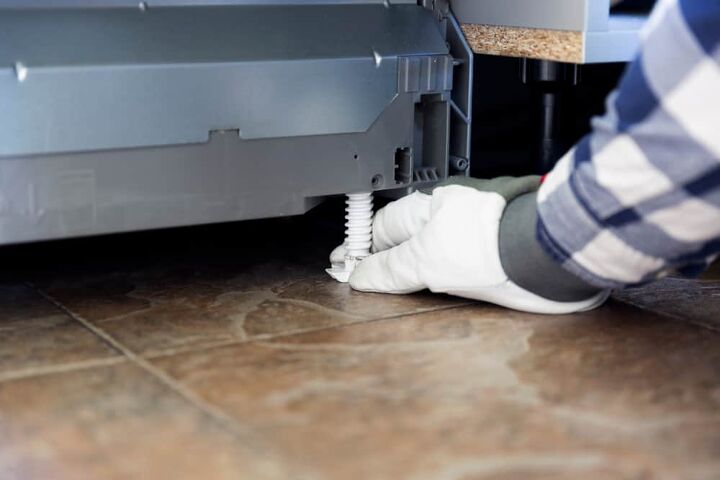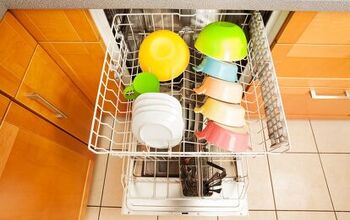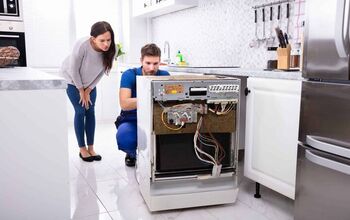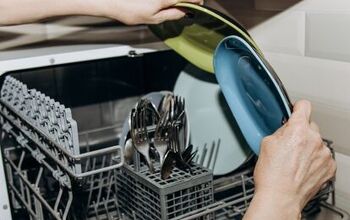How To Remove A Dishwasher With A Raised Floor (The Best Way!)

When you come to the point that you need a new dishwasher, there is the question of removing the old one. Pulling out the existing dishwasher is generally a pretty easy job unless the floor surrounding it has been raised. Raising the floor generally happens after a remodeling effort. Even if the flooring is a half-inch higher, it can make removing the old dishwasher pretty difficult.
Shorten the legs on your dishwasher or remove them entirely and unscrew the surrounding countertops if there are any around them. You may need to pry the countertop up so that you can slide the dishwasher out of the space. Unscrew the dishwasher door and base plate, shorten or remove the legs, and pull the dishwasher out.
Do You Need Handyman Services?
Get free, zero-commitment quotes from pro contractors near you.

Step 1: Cut the Power
Whenever you do any kind of work with any kind of electrical appliance, cutting the power should always be the first step. No matter how rare the chance may be, electrical shock is nothing to scoff at and should be addressed immediately.
You can either turn the power off by removing the plug from the wall or by cutting the power directly from the breaker box. Either way is fine, what matters is that there is no electrical current running through your dishwasher.
Step 2: Cut the Water
While it isn’t dangerous to keep the water on while you work, it will definitely create a mess that will make things far more difficult. As you would with the electric, cut off the supply of water to the dishwasher before starting.
This is done pretty easily by locating the supply valve. It is underneath your sink and can be turned quickly to cut the flow of water to the dishwasher. You can turn it back on when the current unit is removed and the new one installed.
Step 3: Find the Screws
With the water and electric cut off from the dishwasher, it is time to open up the dishwasher door. After doing this, look for the screws that are just above the dishwasher opening. These screws are what hold the dishwasher to the underside of the counter.
Hold the dishwasher in place with one hand and then unscrew each of the screws. Keep them handy in the event that your new model is securable to the underside of the countertop.
Step 4: Base Plate Screws
After removing the screws from the underside of the counter, it is time to close the dishwasher door once again. When the door is closed, take the screws out of the base plate of your dishwasher. The base plate is underneath the door and hides the opening between the floor and the door.
For most units, there should be at least one screw on either side but there can be more. Remove all of them before proceeding on to the next step.
Step 5: Adjusting the Feet
This is the most important step in the process. Locate the feet on the dishwasher, holding one of the front feet between your fingers and thumb. While holding firmly, give it a twist counterclockwise in order to shorten it. This is how you will be able to pull the dishwasher out.
Repeat this process on the other front leg. You should probably lower both legs as much as you possibly can in order to clear the gap between the countertop and the raised flooring. It can be annoying to have to go back and readjust the legs if you don’t do it enough the first time.
Step 6: Remove
Pull the dishwasher forward slowly to ensure that it will come out. There’s a chance that the flooring has been raised so much that the dishwasher still won’t clear the gap even after adjusting the legs. If you just yank on the dishwasher, it could damage the dishwasher, the flooring, or the countertop.
In most cases, though, this should be enough to allow you to remove the old dishwasher safely. When it is removed, you can dispose of it accordingly. Depending on the community, you may even be able to put it on the curb for your municipality’s mass pickup dates.
Can You Take the Feet Off of a Dishwasher?
Depending on the opening that you have to work with, there is a chance that your dishwasher may be too tall to fit even with the feet retracted all the way. So, that begs the question: can you take the feet off of your dishwasher?
The technical answer is yes, but there is one major consideration. The legs aren’t meant to be removed, so cutting them off can possibly void your warranty. Keep that in mind when you are deciding whether or not to remove the legs.
- Cut the legs off. Should you need a little more clearance and are fine violating the terms of the warranty, you can saw them off. A hacksaw blade should be enough to cut the legs off, just be careful not to cut yourself.
- Remove the screws. When you cut off the legs, you should see a screw within. Turn the screws out to remove them entirely. Leaving them in can seriously gouge out your flooring, so make sure that you take them out before putting the dishwasher into its designated space.
- Lay something underneath. When the time comes to put the dishwasher in, make sure that you lay something down. It can be a rug or cardboard, so long as it is thick enough to protect against gouging. With the protective layer down, you can then slide the dishwasher into place.
Should You Tile Underneath a Dishwasher?
This all depends on how much work you want to do, the look you’re hoping to achieve, and a bit of foresight towards swapping out your appliances. The short answer is that it is up to you whether or not to tile underneath of your dishwasher.
There are quite a bit of pros to utilizing this method, and a few cons as well.
- Even flooring. By tiling in the areas that will be occupied by appliances, you can assure that the flooring will be level and even. When it comes to replacing or moving appliances, a level flooring means you can guarantee that the appliance will slide out. With uneven flooring that may not be the case.
- Consistent look. Another reason to install tiling is that you will achieve a consistent look in your flooring. Depending on the dimensions of your dishwasher, you may or may not be able to see the areas of flooring that haven’t been touched. You won’t have to worry about that when you put flooring in the appliance areas.
There are a couple of cons to this method, however.
- Additional work/cost. With more flooring comes more materials. More materials means more installation and higher costs. Granted, it’s not going to be all that much more than the cost of the rest of the flooring, but it will still be noticeable.
- Gouging. A major concern with installing an appliance over flooring is that there is a risk for damage to the flooring. Scraping, scratching, and gouging are all some of the risks that you run by installing appliances over flooring.
Do You Need Handyman Services?
Get free, zero-commitment quotes from pro contractors near you.

Related Questions
Can You Put Heavy Objects on Laminate Flooring?
Laminate flooring is becoming a more popular option thanks to its high-end look with cheaper materials. That said, there are potential risks to using laminate flooring that consumers need to be aware of before purchasing.While laminate flooring tends to offer better scratch and indentation resistance than most of the other types of flooring out there, it isn’t damage-proof. Laminate flooring does pretty good with heavy objects, but make sure that you use common sense and care when moving said objects. Getting careless is the fastest way to deep scratches and gouges that will taunt you each time that you see them.
Do You Need Furniture Pads for Laminate Flooring?
With daily use, even the heaviest of furniture can move slightly across laminate flooring. When there is movement, there is the chance for scratching, gouging, and other damage. So, it only makes sense to implement further measures to protect against that other damage.Furniture pads are a great way to protect your flooring and easily move those appliances when you need to. Furniture pads prevent any sharp parts or the bottom of the appliance from scratching, scraping, and gouging flooring. Best of all, they can be purchased in a wide range of materials: plastic, felt, cane, and carpet among them.
How Do You Keep Appliances from Sliding on Laminate Flooring?
Perhaps you want to go in the other direction, finding something that will prevent those heavy appliances from moving at all. After all, it can be especially annoying to notice that your appliances are off-kilter or slightly out of place compared to where they were before.The best way to keep your appliances from moving on laminate flooring is with rubber padding. You can either buy pre-packaged rubber padding or can simply buy a roll and cut them into manageable strips to fit your specific appliance. Simply lift the appliance up and place the rubber pads under the feet and you should be good to go.

Ryan Womeldorf has more than a decade of experience writing. He loves to blog about construction, plumbing, and other home topics. Ryan also loves hockey and a lifelong Buffalo sports fan.
More by Ryan Womeldorf



























